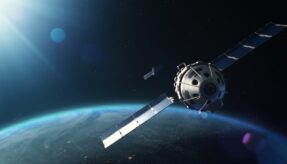
Military involvement in space feels like a futuristic idea but it already plays a large role in many armed forces organisations. Space is increasingly becoming a focus for conflicts, with growing fears over anti-satellite technology becoming more accessible. It is believed by some experts that it could become a battleground for future conflicts.
Space-based research has become more common for many industries and it often leads to major breakthroughs. Materials, human endurance, and chemicals are tested aboard the International Space Station which can lead to huge leaps forward in Earth-based manufacturing. The increased use of weapons such as drones and advanced communications technology means that protecting space assets is more important than ever.
The biggest use of space technology in the military is currently in communications. Messaging and data sending relies on satellite connections and armed forces organisations have invested heavily in satellites. NATO has formally recognised space as the fifth military frontier which will allow them to request capabilities in satellite communication and data imagery from allies. Lockheed Martin recently received a contract from the US Air Force to provide protection from jammed communications.
The ten-year contract covers three constellations used by the US and their allies. Lockheed Martin will provide support and conduct operations to ensure their continued functioning. The contract also promises to focus on space as a warfighting domain and resiliency. The company aims to secure communications for warfighters in the sea, in the air, and on land.
NATO has pledged to protect satellites from compromise and anti-satellite weaponry. Their new recognition of space as the fifth military domain includes the option to request the use of satellite capabilities from member states. Half of the satellites in Earth’s orbit are owned by NATO allies. The annual Global MilSatCom took place in London this year and included discussions of Low Earth Orbit, large constellations, resilience, Beyond Line-of-Sight capability (BLoS) and payload delivery. Military leaders from countries including the Netherlands, the USA, Japan, South Korea, and Norway were in attendance. The main focus of the event was increasing bandwidth to better suit military needs. SpaceX has promised its Starlink broadband service will be available next year and is already being tested in US Air Force aircraft.
NATO has spoken about ambitions to put weapons in space as well as ensuring allies abide by international laws while dealing with the domain. Lieutenant General Scott Kindsvater said that NATO doesn’t have a goal to militarise space, but rather to have the option to call on space for missions and secure interoperability between Earth and space domains. During the space race, governments researched launching their own space stations for military purposes.
The Pentagon Defence Innovation Unit (DUI) is looking at the possibility of an unmanned orbital station to allow for experiments and mission support. In the long term, the Pentagon hopes that a station like this could be used for docking spacecraft and adapted to be suitable for habitation by astronauts. The platform could support experiments in microgravity, manufacturing, logistics and storage, training, hosting payloads, test and evaluation, space assembly, and other functions.
A recent report from the US military expressed concern over the Chinese government’s ambitions in space. The report says that China has plans to ‘dominate’ the industrialisation of space within the moon’s orbit. It says that China has invested a lot in exploring the national security potential of space. It includes recommendations for the US to remain a prominent power in space such as long-term economic space policy, a plan to improve US cooperation with allies, and an interagency plan to protect the US supply chain. The report also calls for an assessment into the Department of Defense’s current capacity to protect communications and navigation assets in space from China’s counter-space technology.
The US Air Force has been experimenting with the unmanned spaceplane X-37B, manufactured by Boeing. The shuttle completed a classified mission at the Kennedy Space Centre in October following 780 days in orbit. The shuttle was launched from a SpaceX Falcon9 rocket. The mission represented the longest flight in the spaceplane’s history. The X-37B is also known as the Orbital Test Vehicle and is around 29ft in length with a 15ft wingspan, meaning it can easily fit into most shuttle launchers. During its most recent flight satellite trackers noted it was in a higher orbit than previous missions, indicating an intention to cover larger parts of the planet.
One of the experiments conducted on the mission was the Air Force Research Laboratory’s Advanced Structurally Embedded Thermal spreader payload. The experiment tested electronics for satellite thermal control systems. The aircraft represents an emerging need for reusable spacecraft due to sectors such as commercial space travel. The EU is looking to develop a space-based early warning system under the Pesco initiative.
The system would be interoperable and contribute to NATO defence. The system would be able to respond to natural and manmade threats. The EU Radio Navigation Solution (EURAS) is coordinated by France and run in cooperation with Italy, Spain, Belgium, Poland, and Germany. The project aims to improve the EU development of military PNT (Positioning, Navigation, and Timing) to take advantage of Galileo and public services. The EU is also looking to improve communications and decision making support tools to assist missions.
Currently, the biggest space-based threat comes from anti-satellite technology. China, India, and Russia have expressed a strong interest in disrupting or destroying satellites, with India launching a test missile to destroy one of its own decommissioned satellites in a recent test. The US has also expressed concern over Russian military ambitions in space. The country has developed technology to disrupt communications and images through denial of service cyberattacks. However, there has been less funding into this compared to other Russian military projects as it is not viewed as a priority.
As it is a relatively new domain there are few international rules for how the military operates in space. The UN Registration Convention would have prohibited any satellites being launched from the X-37B, which some experts say was suggested as an objective in some Air Force reports. However, the only man-made objects attributed to the mission by the Air Force were the X-37B itself and the Falcon 9 upper stage.
Countries including China have been accused of not complying with recommendations. Another concern for the Pentagon is Iran’s advances in Space technology. A recent report fro the Defense Intelligence Agency examined the country’s technological advancements in the space domain. The report says that while Iran has a legitimate civilian space sector they fear that space launch vehicles could lead to ‘Intercontinental ballistic missiles’. Iran has had several successful rocket launches. The main concern for the US government is their nuclear programme, especially fears they may have violated terms of a nuclear agreement, and how rocket launches and other space technology could be used to facilitate it.
If you would like to join our community and read more articles like this then please click here.








